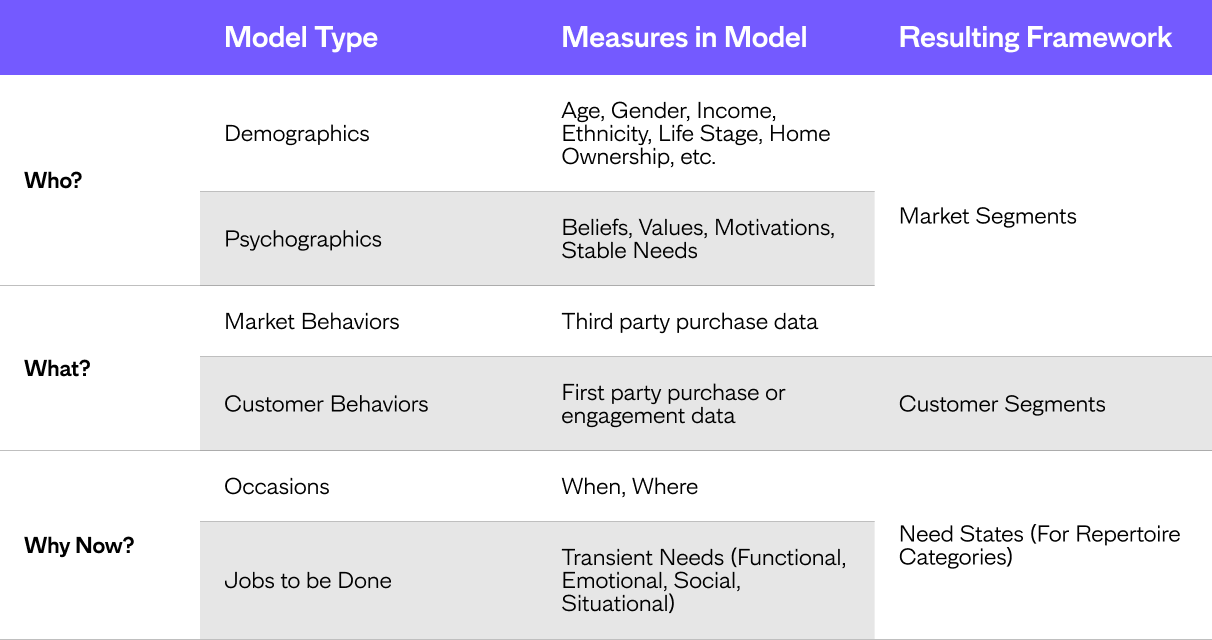Light

This article was written by Hilary DeCamp, Chief Methodologist
Many organizations pursue segmentation as a way to drive customer-centricity into the organization through a shared understanding of who the target customer is and how to serve their needs. One of the additional benefits of the segmentation is that it gets everyone aligned, speaking the same language and marching in the same direction.
But sending all your troops marching in the same direction is not necessarily the best way to win a battle. Some of the greatest military victories in history were had when the infantry, cavalry and archers were all deployed in different directions with distinct tactical goals. Sure, they shared a combined objective of vanquishing the enemy, but their roles in achieving that victory – though interrelated – were purposefully different.
In your organization, the innovation team, the brand marketing team and the customer loyalty team all have distinct goals that ultimately further the shared organizational objectives of increased sales, profit and growth. The paths they take toward achieving these goals will differ. If you give them all the same high-level map, they’re all likely to get lost on the way to their destination. However, give them each a focused view of their piece of the battlefield, in the context of the larger area, and they’ll reach their destinations faster, more efficiently and with less misdirected effort or internal debate over which route to take.
Market Segmentation
The simplest target segments to build and deploy are those defined by demographics. People can easily imagine someone based on their demographics, and media buying platforms make them easy to buy ads against. But demographics are rarely predictive of much beyond technology adoption, so demographically defined segments do little to improve your aim.
Brand strategy and communications teams typically need an attitudes- and needs-based, or psychographics- and lifestyle-based segmentation framework that helps them understand the motivations and preferences of their audiences. This person-level market segmentation helps the brand (or house of brands) choose appropriate targets and deliver tailored acquisition-oriented messages that resonate with high potential audiences.
Some organizations prefer to focus their acquisition efforts on behaviorally defined groups, eschewing the idea that people can understand and express their beliefs or motives. In high velocity categories where category-level purchase data (through Nielsen Catalina, for example) can be used to both cluster consumers and target promotional offers, this approach to market segmentation may be pursued instead, ideally with a survey-based attitudinal overlay to round out the understanding of the “why” behind the “what”.
Customer Segmentation
Customer loyalty teams need to know how to keep existing customers coming back by understanding their engagement frequency and reacting to lapses. They do this through Recency, Frequency and Monetary Value (RFM) models.
But they can go deeper to boost lifetime value by understanding how existing customers like to shop, what they like to buy and what else might be successfully promoted to them. With loyalty programs or logged-in visits, these multi-faceted segments can be defined by observed behaviors and segment membership can be assigned with a high degree of accuracy to all persons in the database. By knowing what customer segment someone belongs to, the loyalty marketing team can personalize email communications and offers, as well as website and app landing pages, to create better conversion rates and retention.
Attitudinal market segments give you foundational understanding and strategic direction, while behavioral segments give you tactical next steps to deploy. Market segmentation is for acquisition while customer segmentation is for retention, cross-sell and upsell.
So, while it’s interesting to know what market segment your existing customers belong to, it’s more powerful to know what customer segment they belong to. Don’t try to predict a customer’s mindset from the small number of transactions they’ve made with you; you don’t have access to what’s in their minds unless you begin to ask them and build up that learning over time.
Occasion-based Segmentation
In categories where people use different brands or products to meet occasion- or situation-specific needs, you may also want a Need State (i.e., Jobs To Be Done) framework. The main use cases for this are portfolio rationalization or alignment and new product innovation, with the goal of boosting share of requirements among current customers.
The following diagram illustrates the three key types of segmentation models and resulting frameworks that may be useful for different teams to achieve their distinct goals.




